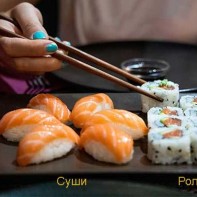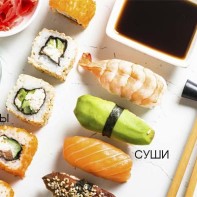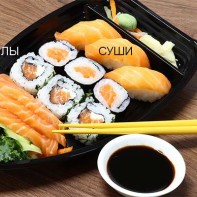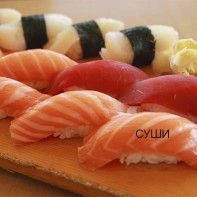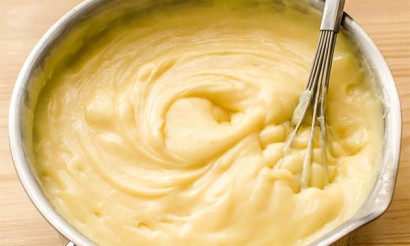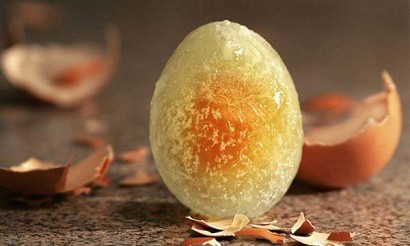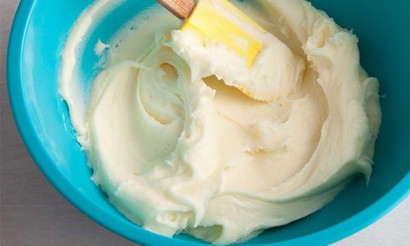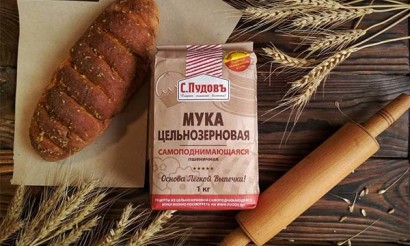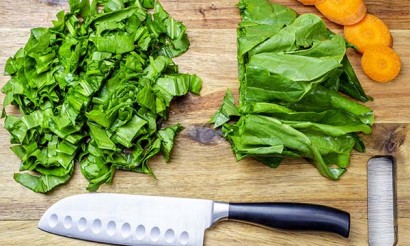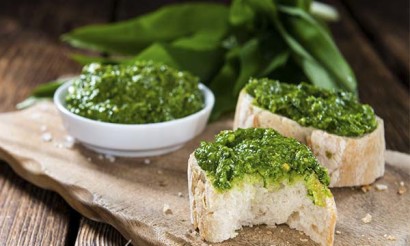Sushi and rolls: what's the difference? The main differences
Rolls, sushi are traditionally Japanese dishes, which many people confuse with each other, not seeing the differences. However, even once you have tried both, you can be convinced that they are completely different dishes with a similar composition of products. In fact, they are prepared according to different technologies, significantly differ sushi from rolls in appearance and even the history of their appearance is completely different.
What is sushi?
Sushi is a product of rice and seafood, which are small-sized rice "pads", where fish or shrimp are placed on top. Rice is prepared using a special technique and sprinkled with rice vinegar to prevent it from falling apart. Sometimes, to bind together a "pillow" and "cap" using a strip of nori seaweed. In sushi, only seafood delicacies - fish, octopus, shrimp - are always used as stuffing-hat.
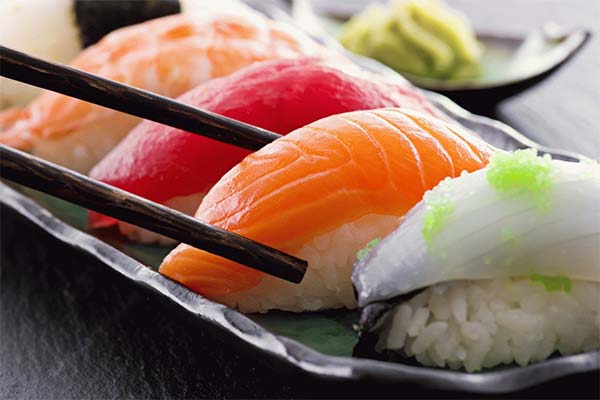
Ideally, the traditional rice for sushi is not boiled, and steamed by a special technology. Afterwards, it is sprinkled with rice vinegar and shaped with water-soaked hands. Sushi is served cold on wooden trays or ceramic flat plates, along with wasabi, soy sauce, and pickled ginger. Sushi is eaten with chopsticks that are used to catch the product and dip it into the sauce on the fish side and send it to the mouth. Sushi is not taken in bites but eaten as a whole.
Important: if you do not have the knack of eating with chopsticks, you can eat sushi with your hands, but never with a fork!
History of Appearance
Sushi is traditionally a favorite delicacy of the Japanese. However, not everyone knows that their homeland is an entirely different country. And, it is China. In ancient times, the Chinese after a good catch of fish, in order to preserve it for a long time, cut it into thin plates, which were covered with rice. The juices of the rice were absorbed by the fish, and in turn, the rice fermented, which prevented the carcasses from spoiling.
Storing fish in rice soon became the most popular way in Asian countries to keep food from spoiling. The Japanese also appreciated it and went a step further. One enterprising chef, based on this method of preserving seafood, came up with a culinary dish that included raw fish. Fortunately, there was plenty of fresh fish in Japan. Then sushi began to gain popularity, gradually spreading around the world. In the middle of the last century, the inhabitants of the entire planet knew about them.
Interestingly, at first the ancient method of preserving seafood rice was not eaten. They only ate the fish and threw the rice away. And it was the Japanese who came up with the idea of eating it along with the fish, indicating their rationalism. The ancient pickled sushi was called nare sushi. They were very sour because during the fermentation process, the rice gave off vinegar. Hence came the tradition of using rice vinegar in cooking sushi later on. Needless to say, this dish had a specific flavor when cooked this way?
Generally speaking, the word "sushi" translates to "pickled fish. However, such a translation does not reflect the true composition of the dish, because raw fish is used. But if you know the history of the origin of sushi, the answer becomes clear: this was the name of the ancient Chinese method of preserving fish with rice. In general, the main ingredient of Japanese cuisine is rice, which even Buddha called "grains of health. In combination with fish you get dishes that are healthy, tasty and easy on the digestive system and do not harm the human body.
What to eat with
Fans of Japanese cuisine will not be out of place to know - how and with what sushi is served. On the table must be present:
- soy sauce;
- wasabi;
- pickled ginger;
- rice vinegar;
- nut sauce.
The most suitable sauce for sushi is wasabi, which is spicy and tangy in flavor. Wasabi is a Japanese horseradish that contains many beneficial substances for the body. It's great for sushi with salmon and crab meat. Soy sauce is a necessary accompaniment to Japanese dishes. It is used to dip sushi, which tastes a little bland. Soy sauce adds a salty taste to sushi and it goes well with rice and seafood.
Wasabi and soy sauce are served in small bowls. Rice vinegar is used to marinate rice, but it can also be used directly to eat Japanese dishes. It has a light flavor and a unique aftertaste. But the rice vinegar has to be expensive and of good quality as it is the only way to unleash the extraordinary taste of the sushi.
The sushi can be accompanied by pickled ginger and nut sauce. The latter is made from nuts, sesame seeds and lemon juice. Nut sauce and ginger are not required when serving sushi, but you can experiment with them.
The main types of sushi
The main types of sushi are as follows:
- Nigiri sushi - traditional items made of rolled into a ball of rice and a slice of fish, shrimp, or octopus.
- Tamago sushi - Japanese omelettes are placed on an oval of rice and tied with a ribbon of nori.
- Chirashi-sushi is completely different in appearance to the classic dishes, because here the boiled rice seasoned with vinegar is placed in a bowl with raw fish and sashimi added on top.
In Japan, our usual rolls are called maki-sushi.
What is a rolls
Rolls are rolls of nori seaweed filled with rice, seafood, fish, fresh cucumber, avocado, cream cheese or cottage cheese, which are sliced in portions. They are square or rounded items that are eaten with chopsticks, hooked one at a time and dipped in the sauce with the rib.
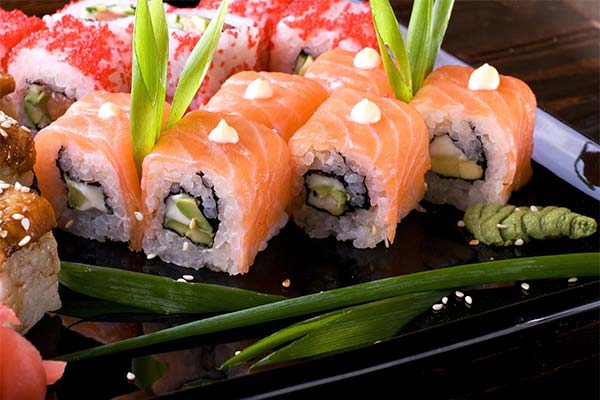
The rolls are served with wasabi, soy sauce, and pickled ginger. It is mandatory that the roll contains rice and nori seaweed, and the filling can be any. The preparation consists of placing rice and stuffing on an unfolded sheet of seaweed, then using a bamboo mat, twist everything into a roll and cut portion by portion. In the case of "inverted" rolls, the first ingredient is rice, then put all the other products on it and then roll up as described. The rolls are served on a flat ceramic plate.
History of Appearance
It is strange that rolls are not a Japanese dish, but their homeland is considered the United States. For example, the most famous and beloved by many rolls called California was invented by an American chef in the late 1970s. The dish arose after the Americans did not like the traditional Japanese sushi. Therefore, the resourceful chef figured out how to improve the taste of the fish dish by simply wrapping the classic ingredients in rice. This is how the very first rolls appeared - California, the recipe of which was further modified and improved. Later, the Japanese developed this culinary tradition and began to use for rolls different fillings, sesame seeds, cheese, as well as seaweed nori, in which other ingredients were wrapped.
What to eat with
The best appetizer for rolls is pickled ginger. It refreshes the taste buds, so it gives foodies the opportunity to fully experience each type of roll in all their variety. It is impossible to eat without soy sauce, which must be dipped into every roll. Wasabi and nut sauce are also a good addition. All appetizers and sauces are served together with the rolls in miniature bowls. Chopsticks are placed next to them.
In Japan, sushi and rolls are served with a salad of fresh vegetables or seaweed sprinkled with sesame seeds, tempura - fried in batter vegetable and fish slices, as well as miso soup. With these dishes, true Japanese gourmets unhurriedly indulge in traditional food, feeling every taste of healthy, delicious food.
Roll varieties
Today, there are several varieties of rolls that roll lovers are not even aware of. After all, in most countries they cook traditional rolls, which in Japan are called makizushi. Their shape is cylindrical. The basis is nori seaweed, in the sheets of which rice and filling are wrapped. Also popular in Japan:
- Tamaki - a variation of the classic rolls, only huge in size with lots of rice and fish fillings.
- Hosomaki - small items wrapped in sheets of seaweed, with avocado necessarily put in the filling.
- Uramaki - an inverted roll, with nori on the inside and rice or red fish on the outside.
- Futomaki - rolls of several kinds of stuffing.
In addition to varieties, rolls are also classified according to the ingredients that make up the filling. But we will talk about them below. Many gourmets like hot rolls - tempura, which are baked in the oven after forming. A set of products - standard.
Sushi and rolls: what's the difference
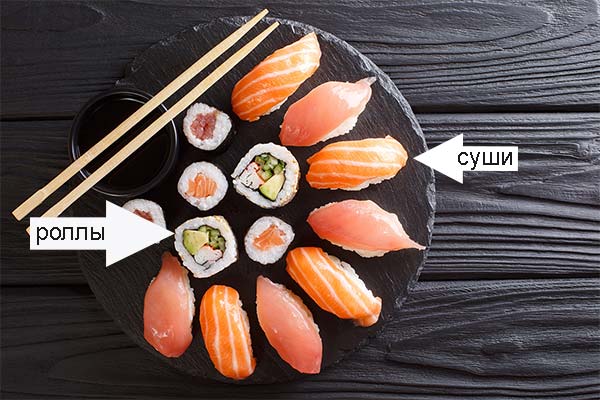
The set of products for rolls and sushi is almost the same. It is fish or seafood, rice. But, the main difference between these dishes is the method of cooking and serving. In appearance, the culinary products are very different from each other. At the same time, sushi can contain only rice, fish or seafood. Whereas for rolls use different types of toppings, even sweet. Rolls can be widely experimented with, combining toppings, changing the type of cheese, etc. With sushi such experiments can not be done. Their composition is quite monotonous. However, sushi is a favorite food of many followers of the right diet who do not accept the combination of a large variety of products in the dish.
The difference between the two dishes is that sushi is eaten only when cold. They cannot be heat-treated. Rolls, on the other hand, can be baked and eaten hot. It is mandatory to use nori seaweed in rolls, but, and sushi can also be made without it.
Which is tastier: sushi or rolls
Which is tastier: rolls or sushi? There is no simple answer to this question. After all, everyone has different tastebuds. As for the Japanese, they prefer sushi, using fresh fish and seafood in the preparation. Not every country has the opportunity to get acquainted with freshly caught fish in the raw form. Once the product is frozen is no longer suitable for cooking sushi. However, in many countries, the most popular are rolls. After all, in their preparation there are no strict rules regarding the products for the filling. You can use different ingredients, and if necessary, replace one with another. And there are more varieties of rolls than there are types of sushi.
What are the most popular rolls and sushi
The most popular in Russia and around the world are considered uramaki - rolls, in which the top layer is rice, and inside are seaweed and stuffing. On top they are sprinkled with sesame seeds. Very popular among all nations of the world are the Philadelphia uramaki, which uses salmon fillets and creamy Philadelphia cheese as toppings. Hence the name of the dish. Cucumbers, caviar, avocado, and crab sticks are used to complement the dish.
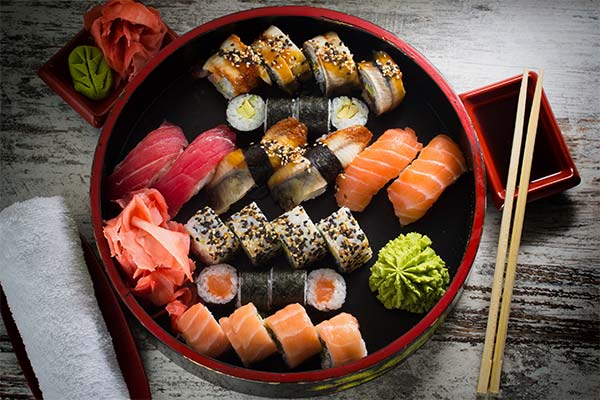
Not to mention the California rolls, which also belong to the uramaki. Caviar, avocado, seaweed, and crab meat are wrapped in white rice. Then, the finished products are dipped in tobiko caviar, which has a bright orange color, making the rolls unusually bright, spectacular. Tempura is also a popular roll in many countries. These are hot items, with different fillings, that are baked in the oven in an extraordinarily delicious batter. They cook very quickly, so the filling stays raw inside, which is exactly what we need.
However, the Japanese, who are true gourmets, prefer hosomaki - classic rolls, where the filling is wrapped in seaweed. They are also divided into different types: vegetarian, with salmon, eel, and tuna. In the Land of the Rising Sun, however, they are made with only one kind of filling and are called mono-rolls. In other countries, it is more common to serve rolls with a combination of toppings. Mono-hosomaki can be found in all Japanese restaurants.
Among the most famous sushi in the world, without a doubt, are nigiri-sushi or nigirizushi. The main ingredient here is fish or shrimp, an additional ingredient is rice.
«Important: All information on this site is provided solely for introductory for introductory purposes only. Before applying any recommendations, consult a health care professional. specialist. Neither the editors nor the authors shall be held liable for any possible harm caused by materials."

